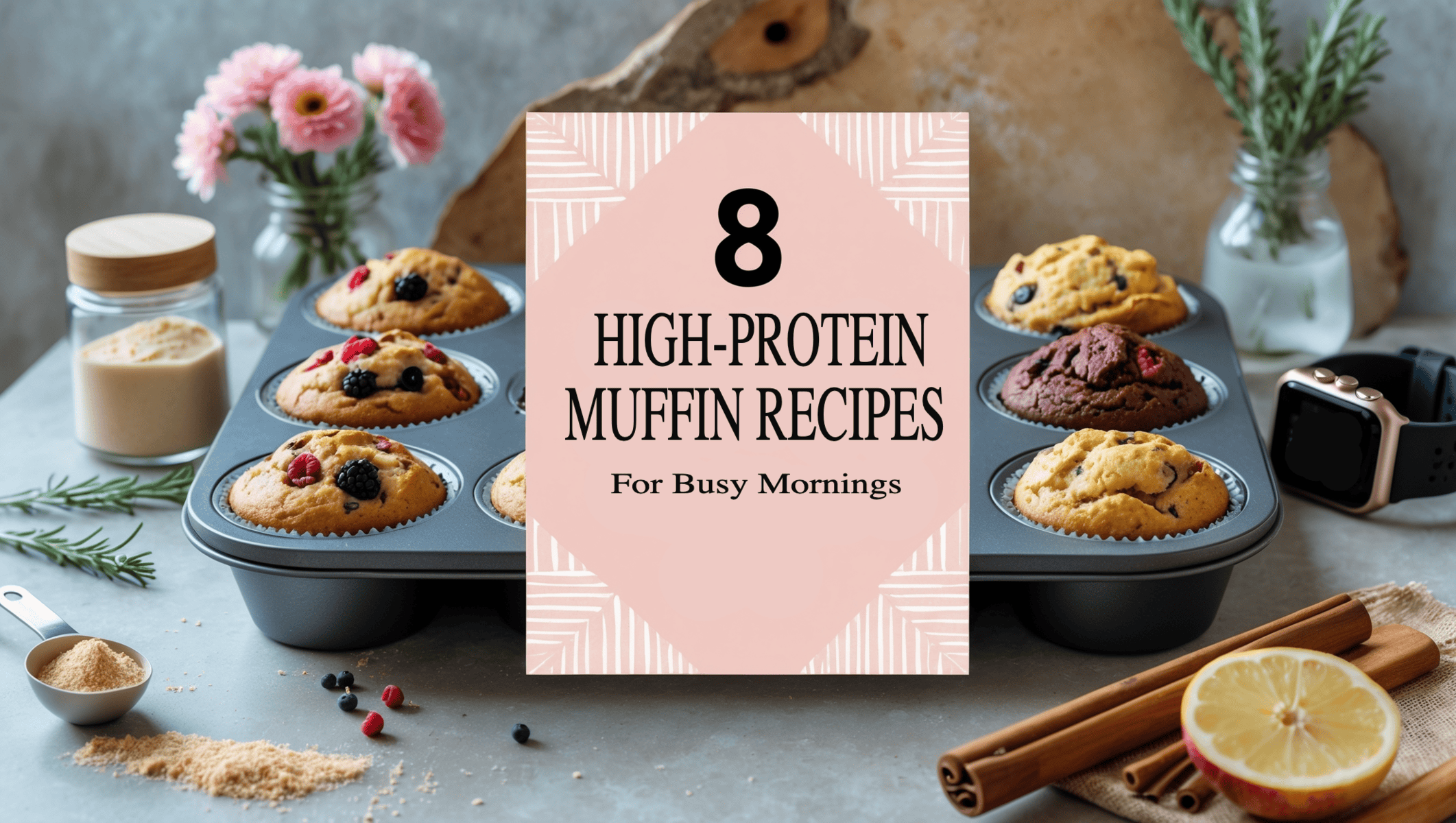
Are you constantly juggling a hectic schedule while trying to maintain a healthy diet? Finding nutritious breakfast options that don’t require waking up at dawn can feel impossible! High-protein muffins might be exactly what you need to revolutionize your morning routine. These convenient, portable powerhouses pack a serious nutritional punch while satisfying your taste buds and keeping hunger at bay until lunchtime.
As someone who’s experimented with countless protein-packed recipes, I’ve discovered that muffins are the perfect vehicle for combining delicious flavors with muscle-building ingredients. The beauty of these recipes lies in their versatility—whether you prefer sweet or savory, fruity or chocolatey, there’s a protein muffin variation waiting to become your new favorite breakfast companion. Plus, they’re ideal for meal prep, allowing you to bake once and enjoy stress-free breakfasts all week long.
In this comprehensive guide, I’ll walk you through eight foolproof high-protein muffin recipes that even kitchen novices can master. We’ll explore everything from classic blueberry to savory egg variations, with each recipe designed to deliver maximum protein with minimum fuss. You’ll also learn essential baking tips, storage techniques, and common pitfalls to avoid. By the time you finish reading, you’ll be equipped with all the knowledge you need to transform your breakfast game and support your health goals without sacrificing flavor or precious morning time!
This post may contain some affiliate links. I only recommend products and services I genuinely believe in. Additionally, some content on this website may have been created with the help of AI.
What You Might Need
- Standard 12-cup muffin tin
- Silicon muffin liners or paper liners
- Mixing bowls (large and medium)
- Measuring cups and spoons
- Whisk and rubber spatula
- Cooling rack
- Food processor or blender (for some recipes)
- Quality protein powder (whey, plant-based, or your preference)
- Storage containers for freezing
Why High-Protein Muffins Are the Perfect Healthy Breakfast Option

When I first started experimenting with protein-packed breakfasts, I was skeptical that anything could replace my beloved sugary cereal. But after experiencing the difference in my energy levels and hunger management throughout the day, I became a complete convert to starting my morning with protein! High-protein muffins have become my go-to recommendation for clients and friends looking to improve their nutrition without sacrificing convenience or taste. You’ll find that incorporating these into your routine creates a foundation for more balanced eating throughout your day.
Protein-rich breakfasts are scientifically proven to help stabilize blood sugar levels, preventing the mid-morning crash that sends you searching for sugary snacks. These muffins offer a perfect solution by providing sustained energy through a balanced combination of protein, complex carbohydrates, and healthy fats. When you prepare a batch on weekends, you’ll have grab-and-go breakfasts ready for those hectic mornings when nutrition might otherwise take a backseat to convenience.
Benefits of Protein for Breakfast
Starting your day with adequate protein helps kickstart your metabolism and provides essential amino acids for muscle maintenance and recovery. Studies show consuming 20-30g of protein at breakfast can help control appetite throughout the day.
Morning Energy Without Crashes
Unlike traditional sugar-laden muffins, high-protein versions provide sustained energy by balancing macronutrients and stabilizing blood sugar. You’ll notice improved focus and stamina until lunchtime.
Time-Saving Meal Preparation
Batch-cooking protein muffins on weekends means nutritious breakfasts are ready when you are. This eliminates decision fatigue and helps maintain consistent healthy eating habits even during busy weeks.
How to Incorporate Protein Muffins Into Your Routine
- Prepare a double batch on Sunday for the entire week
- Pair with Greek yogurt or a boiled egg for extra protein
- Pack in your bag for post-workout refueling
- Keep frozen individually wrapped muffins for emergency nutrition
- Serve as a healthy alternative at brunches or breakfast meetings
Picture This
It’s 7:30 AM on a Tuesday—you’ve hit snooze twice and now you’re rushing to get out the door. Instead of skipping breakfast or grabbing something processed from a drive-thru, you reach into your refrigerator for a chocolate banana protein muffin you made on Sunday. As you commute to work, you enjoy this delicious, nutritionally balanced breakfast that keeps you satisfied and energized through your morning meetings. Your colleagues wonder how you manage to look so vibrant despite your busy schedule, while you smile knowing your secret weapon is those high-protein muffins waiting at home.
Essential Equipment and Ingredients for High-Protein Muffins
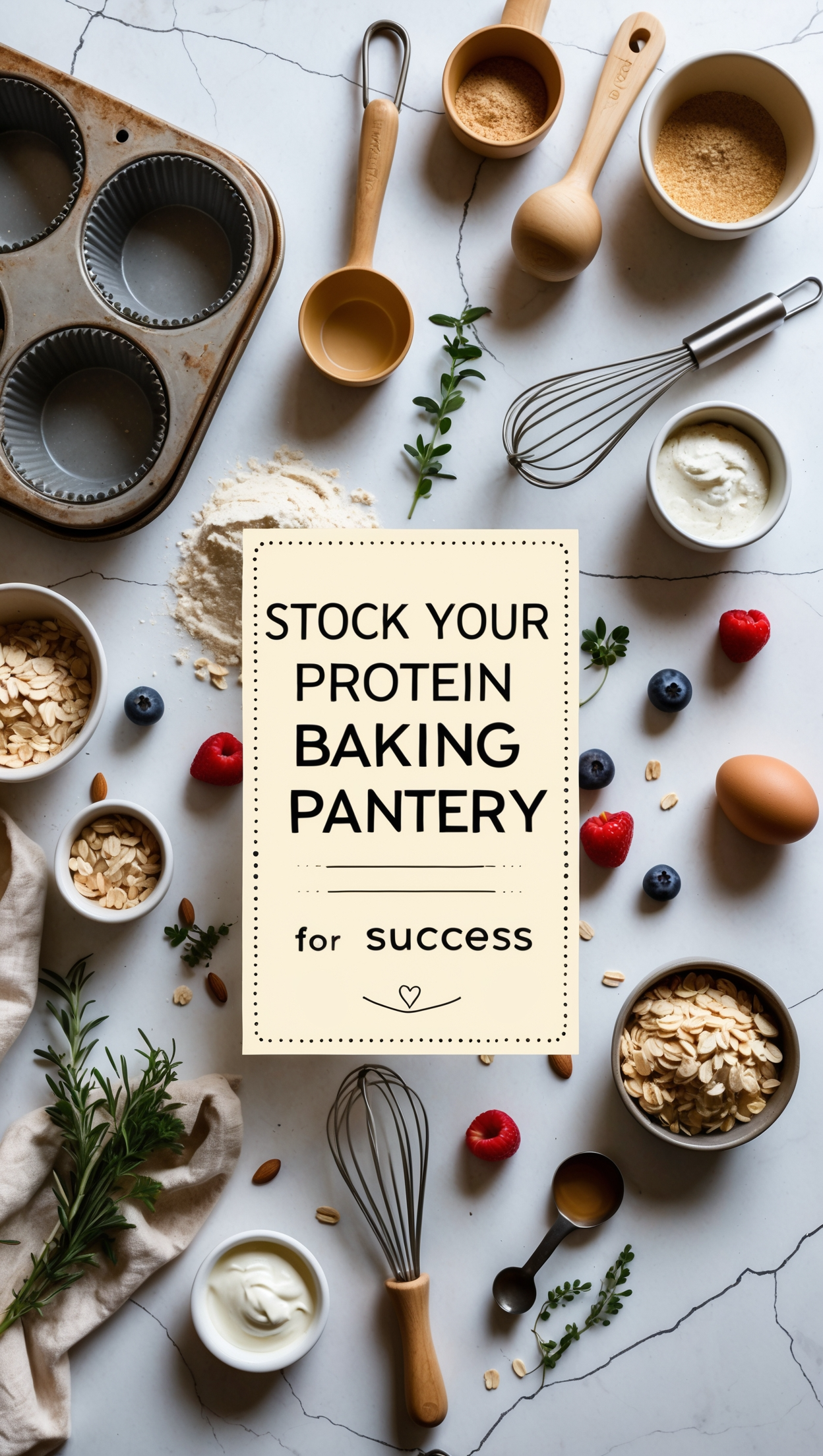
My journey into protein baking began with many failed experiments—dense, rubbery muffins that went straight into the trash! Through trial and error, I discovered that success depends largely on having the right tools and understanding how protein-rich ingredients behave differently than traditional baking ingredients. You’ll save yourself much frustration by investing in a few key items and familiarizing yourself with protein-friendly alternatives to conventional baking staples.
Starting with quality equipment doesn’t mean breaking the bank—a standard muffin tin and reliable measuring tools are the foundation of successful baking. Where you do want to be selective is with your protein sources and flour alternatives. The protein powder you choose significantly impacts the texture and flavor of your muffins, while alternative flours like almond or oat can dramatically increase the nutritional profile compared to all-purpose flour.
Choosing the Right Protein Powder
Select a high-quality protein powder that complements your recipe’s flavor profile. Whey isolate works well for most bakers, while plant-based options like pea protein suit vegan recipes despite sometimes creating denser textures.
Flour Alternatives for Higher Protein Content
Almond flour, coconut flour, and oat flour not only boost protein content but also add beneficial fiber and healthy fats. Remember that these alternatives absorb moisture differently than wheat flour.
Natural Sweetening Options
Banana, unsweetened applesauce, monk fruit extract, and stevia can replace refined sugar while keeping the carb content reasonable. These alternatives often require adjusting other liquid ingredients.
How to Stock Your Protein Baking Pantry
- Invest in airtight containers for storing alternative flours
- Purchase measuring spoons specifically for sticky ingredients like honey
- Stock frozen fruit for easy addition to recipes
- Keep eggs, Greek yogurt, and cottage cheese as reliable protein sources
- Have a variety of spices on hand to enhance flavors without adding calories
Picture This
Your kitchen counter displays a lineup of ingredients that might surprise traditional bakers—a container of vanilla protein powder sits next to almond flour and ground flaxseed. As you mix your high-protein muffin batter, the familiar scent of cinnamon and vanilla fills the air, but the nutritional profile of what’s going into your muffin tin is vastly superior to conventional recipes. After years of perfecting your approach, you now confidently substitute ingredients based on what’s available, knowing the fundamental principles of protein baking ensure delicious results every time. Friends regularly ask for your secret to creating treats that taste indulgent while supporting their fitness goals.
1. Classic Blueberry Protein Muffins

The humble blueberry muffin was my first venture into protein baking, and I still remember the satisfaction of biting into that first successful batch! There’s something deeply comforting about the contrast between juicy berries and warm, tender muffin crumb. You’ll find this protein-enhanced version retains all the nostalgic charm of traditional blueberry muffins while delivering substantial nutritional benefits that keep you energized throughout your morning.
What makes these muffins special is the perfect balance between protein powder, Greek yogurt, and almond flour—creating a moist texture that avoids the dryness often associated with protein baking. The natural sweetness from banana reduces the need for added sugar, while fresh or frozen blueberries burst with flavor and antioxidants. These muffins prove that classic favorites can be reinvented to support your health goals without sacrificing the joy of eating something truly delicious.
Benefits of Blueberries in Protein Baking
Beyond their delicious flavor, blueberries provide potent antioxidants that combat inflammation and support brain health. Their natural sweetness reduces the need for added sugar while providing beneficial fiber.
Protein Sources in This Recipe
Greek yogurt and whey protein combine to deliver approximately 10g of protein per muffin. This protein duo creates a complete amino acid profile while contributing to a moist texture.
Perfect Texture Techniques
Folding blueberries gently into the batter prevents breaking them and turning your muffins purple. Coating frozen berries in a teaspoon of flour before folding prevents them from sinking to the bottom.
How to Make Classic Blueberry Protein Muffins
- Preheat oven to 350°F and prepare your muffin tin with liners
- Combine 1 cup almond flour, ½ cup oat flour, 2 scoops vanilla protein powder, 1 tsp baking powder, ½ tsp cinnamon, and ¼ tsp salt
- In a separate bowl, mix 2 mashed bananas, ¼ cup Greek yogurt, 2 eggs, 2 tbsp maple syrup, and 1 tsp vanilla extract
- Combine wet and dry ingredients without overmixing
- Fold in 1 cup fresh or frozen blueberries
- Bake for 20-22 minutes until a toothpick comes out clean
- Cool completely before storing
Picture This
The kitchen fills with the irresistible aroma of blueberry muffins baking on a Sunday morning. As you remove the tin from the oven, you see perfectly domed muffins with juicy blueberries peeking through golden tops. Taking your first bite, you’re greeted with a tender crumb studded with warm, bursting berries—but unlike traditional muffins that leave you hungry an hour later, these high-protein blueberry muffins keep you satisfied through your morning workout and beyond. Your family doesn’t even realize they’re enjoying a protein-packed breakfast that supports their health goals while tasting like a weekend treat.
2. Chocolate Banana Protein Muffins

I developed this chocolate banana protein muffin recipe during a particularly stressful work period when I desperately needed something that felt indulgent but wouldn’t derail my nutrition goals! The combination of rich cocoa powder, naturally sweet bananas, and satisfying protein creates an almost dessert-like experience that’s actually beneficial for your body. You’ll appreciate how these muffins satisfy chocolate cravings while providing sustained energy rather than the crash associated with conventional chocolate treats.
What makes these muffins special is their versatility—they’re equally appropriate as breakfast, a post-workout snack, or a healthier dessert option. The ripe bananas not only provide natural sweetness but also create a moisture content that combines perfectly with protein powder without becoming dry. Even children and picky eaters who might resist “healthy” options tend to embrace these chocolate treats without realizing they’re consuming a protein-packed alternative to traditional chocolate muffins.
The Perfect Chocolate Flavor Profile
Using high-quality cocoa powder provides rich chocolate flavor without excess sugar. Combining it with chocolate protein powder intensifies the taste while boosting the protein content to approximately 12g per muffin.
Banana as a Natural Sweetener
Very ripe bananas with brown spots contain more natural sugars and provide perfect sweetness and moisture. They also contribute potassium and other nutrients while reducing the need for oils.
Supporting Muscle Recovery
The combination of fast-absorbing whey protein with slower-digesting casein from Greek yogurt creates an ideal protein blend for muscle recovery and growth. These muffins make an excellent post-workout option.
How to Make Chocolate Banana Protein Muffins
- Preheat oven to 350°F and prepare your muffin tin with liners
- Mash 3 very ripe bananas in a large bowl
- Add 2 eggs, ¼ cup Greek yogurt, 2 tbsp maple syrup, and 1 tsp vanilla extract
- In a separate bowl, combine 1 cup oat flour, 2 scoops chocolate protein powder, ¼ cup cocoa powder, 1 tsp baking powder, ½ tsp baking soda, and ¼ tsp salt
- Mix wet and dry ingredients until just combined
- Fold in ¼ cup dark chocolate chips (optional)
- Bake for 18-20 minutes until a toothpick comes out clean
- Allow to cool before enjoying
Picture This
As you unwrap a chocolate banana protein muffin at your desk, colleagues stop by commenting on the rich chocolate aroma. Taking a bite, you experience the perfect balance of moist banana bread texture with deep chocolate flavor—a combination that feels indulgent yet fuels your body with protein and complex carbohydrates. The satisfaction of enjoying something so delicious while supporting your fitness goals brings a smile to your face. When a coworker asks for the recipe, surprised it contains protein powder, you explain how these high-protein chocolate banana muffins have become your secret weapon for maintaining energy throughout demanding workdays while satisfying chocolate cravings in a nutritious way.
3. Peanut Butter Protein Muffins
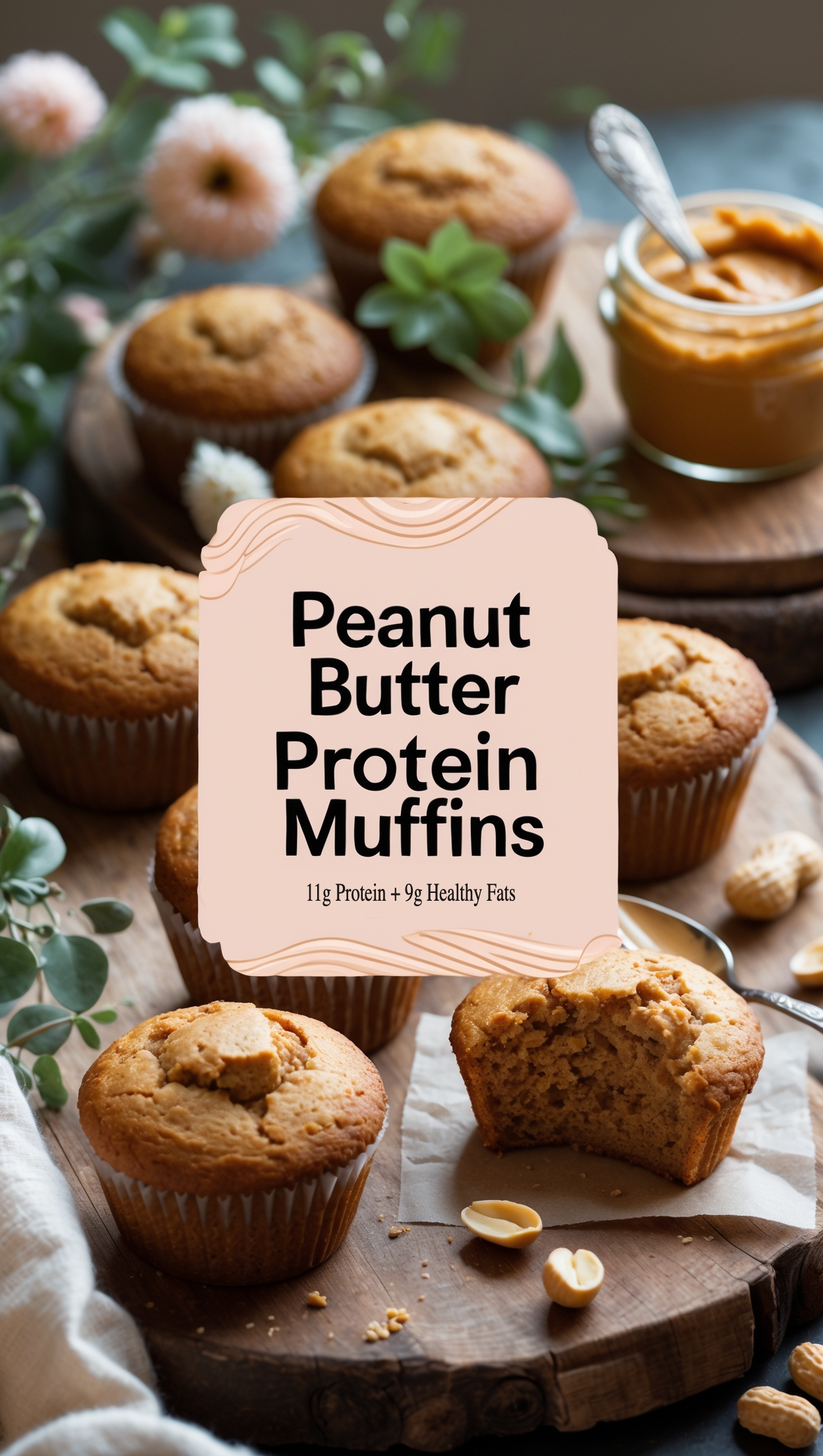
Peanut butter holds a special place in my heart—and my kitchen! When I first created these protein-packed peanut butter muffins, they quickly became a staple in my meal prep routine. The rich, nutty flavor pairs perfectly with the subtle sweetness from honey and banana, creating a satisfying treat that feels indulgent while supporting your nutrition goals. You’ll find the combination of peanut butter and protein powder creates a uniquely satiating muffin that keeps hunger at bay for hours.
What makes these muffins exceptional is their macro profile—offering an ideal balance of protein, healthy fats, and complex carbohydrates. The peanut butter not only adds delicious flavor but also contributes healthy monounsaturated fats and additional protein. I’ve found these to be particularly popular with children and teenagers who might otherwise resist healthier options, making them perfect for active families trying to incorporate more protein into their diets without sacrificing flavor.
Peanut Butter Nutrition Benefits
Beyond its irresistible taste, natural peanut butter provides plant-based protein, heart-healthy fats, and important micronutrients like vitamin E and magnesium. Choosing unsweetened natural varieties maximizes nutritional benefits.
Balancing Macronutrients for Satiety
The combination of protein and healthy fats creates exceptional satiety, making these muffins perfect for busy mornings. Each muffin delivers approximately 11g of protein and 9g of healthy fats.
Allergen-Friendly Alternatives
For those with peanut allergies, almond butter, sunflower seed butter, or even tahini can create equally delicious variations. Each alternative brings its own unique nutritional profile and flavor notes.
How to Make Peanut Butter Protein Muffins
- Preheat oven to 350°F and prepare your muffin tin with liners
- Combine ½ cup natural peanut butter, 1 mashed banana, 2 eggs, ¼ cup honey, and 1 tsp vanilla extract
- In a separate bowl, mix 1 cup oat flour, 2 scoops vanilla protein powder, 1 tsp baking powder, ½ tsp cinnamon, and ¼ tsp salt
- Combine wet and dry ingredients without overmixing
- Spoon into muffin liners, then swirl additional peanut butter on top of each muffin
- Bake for 18-20 minutes until golden and set
- Cool completely before storing
Picture This
The distinctive aroma of peanut butter fills your kitchen as these protein muffins rise in the oven. After cooling, you take your first bite and experience the perfect balance of nutty richness complemented by subtle sweetness and a tender crumb structure. Unlike conventional peanut butter baked goods that often leave you with a sugar crash, these high-protein peanut butter muffins provide lasting energy through your morning meetings or afternoon activities. You’ve packed one in your gym bag for post-workout recovery, knowing its ideal protein-to-carb ratio will support muscle repair while satisfying your hunger, demonstrating how strategic nutrition can be both delicious and functional.
4. Pumpkin Spice Protein Muffins

My obsession with pumpkin spice isn’t limited to fall—these protein-packed muffins have earned a permanent place in my recipe collection regardless of season! The warming combination of cinnamon, nutmeg, and cloves paired with real pumpkin puree creates a muffin that feels like comfort food while delivering impressive nutritional benefits. You’ll appreciate how these muffins bring cozy seasonal flavors into a protein-rich format that supports your health goals year-round.
The secret to these muffins’ success lies in the moisture content from pumpkin puree, which pairs perfectly with protein powder without creating the dryness common in protein baking. Beyond its flavor contribution, pumpkin adds significant nutritional value through beta-carotene, fiber, and potassium. I’ve served these to countless guests who were shocked to learn they were enjoying a high-protein treat rather than a traditional pumpkin muffin from a bakery.
Pumpkin’s Nutritional Powerhouse
Beyond its delicious flavor, pumpkin puree provides vitamin A, fiber, and antioxidants while contributing moisture that prevents protein baking from becoming dry. Its natural sweetness reduces the need for added sugars.
Spice Blend Perfection
The traditional pumpkin spice blend of cinnamon, nutmeg, ginger, and cloves offers more than flavor—these spices have anti-inflammatory properties and can help regulate blood sugar. Freshly ground spices provide the most vibrant flavor.
Year-Round Availability
Unlike seasonal lattes, these muffins can be enjoyed any time using canned pumpkin puree. Buying in bulk during fall sales and storing extra cans makes this recipe economical throughout the year.
How to Make Pumpkin Spice Protein Muffins
- Preheat oven to 350°F and prepare your muffin tin with liners
- Combine 1 cup pumpkin puree, 2 eggs, ¼ cup maple syrup, 2 tbsp melted coconut oil, and 1 tsp vanilla extract
- In a separate bowl, mix 1 cup oat flour, 2 scoops vanilla protein powder, 2 tsp pumpkin pie spice, 1 tsp baking powder, ½ tsp baking soda, and ¼ tsp salt
- Combine wet and dry ingredients without overmixing
- Fold in ¼ cup chopped pecans (optional)
- Bake for 20-22 minutes until a toothpick comes out clean
- Allow to cool completely before storing
Picture This
The intoxicating scent of pumpkin spice fills your home as these protein muffins bake to perfection. Pulling the tray from the oven reveals beautifully domed tops with a rich amber color that promises authentic pumpkin flavor. With your first bite, you experience the perfect balance of warm spices, natural pumpkin sweetness, and a moist, tender texture that defies typical protein baking. These high-protein pumpkin spice muffins bridge the gap between nutritious and delicious, proving that strategic ingredient choices can transform seasonal favorites into everyday nutrition that supports your active lifestyle while satisfying comfort food cravings throughout the year.
5. Lemon Poppy Seed Protein Muffins
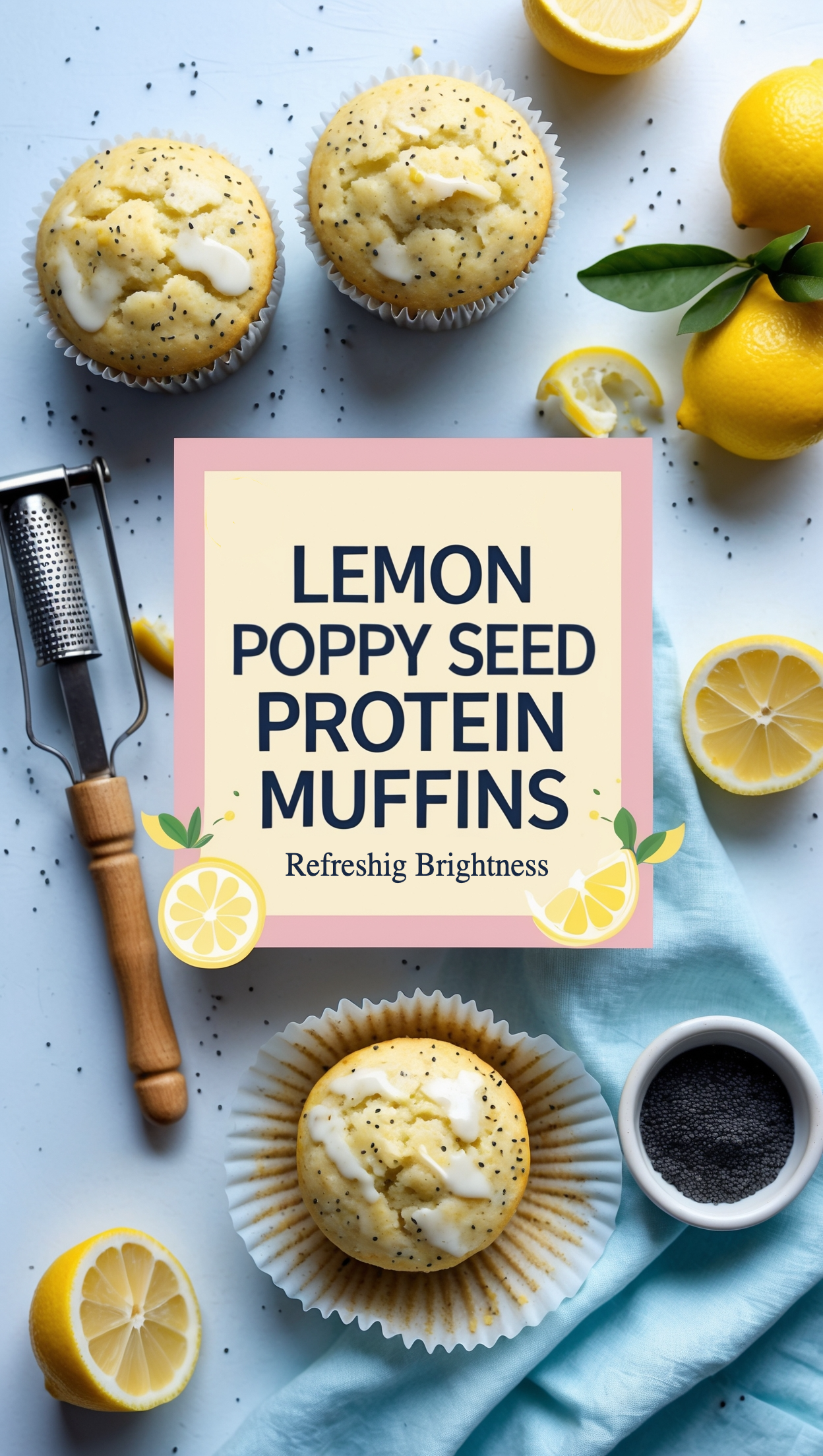
The bright, zesty flavor of lemon poppy seed muffins has always lifted my spirits, and creating a protein-rich version became my personal challenge during a particularly dreary winter! The vibrant citrus notes paired with subtle crunch from poppy seeds create a refreshing alternative to heavier flavor profiles. You’ll find these muffins bring a welcome brightness to your breakfast routine while delivering the protein necessary for sustained energy throughout your morning.
What sets these muffins apart is their versatility across seasons—equally appropriate for summer brunches or winter mornings when you need a reminder of sunshine. The addition of Greek yogurt not only increases protein content but also enhances the tangy flavor profile that complements the lemon perfectly. These muffins demonstrate that protein-rich baking can extend far beyond chocolate and peanut butter into refreshing, lighter flavor territories without sacrificing nutritional benefits.
Citrus Flavor Enhancement
Fresh lemon zest contains essential oils that provide intense flavor without additional calories. Combining zest with fresh lemon juice creates a vibrant citrus profile that brightens the entire muffin.
Poppy Seed Nutritional Benefits
Despite their tiny size, poppy seeds contribute calcium, magnesium, and fiber while providing their signature subtle crunch. Their mild nutty flavor complements the bright lemon perfectly.
Yogurt-Based Moisture
Greek yogurt contributes approximately 5g of protein per muffin while creating a tender crumb structure. The natural tanginess enhances the lemon flavor while reducing the need for added fats.
How to Make Lemon Poppy Seed Protein Muffins
- Preheat oven to 350°F and prepare your muffin tin with liners
- Combine ¾ cup Greek yogurt, 2 eggs, 3 tbsp honey, 3 tbsp fresh lemon juice, and 2 tbsp lemon zest
- In a separate bowl, mix 1 cup oat flour, 2 scoops vanilla protein powder, 1 tsp baking powder, ½ tsp baking soda, ¼ tsp salt, and 2 tbsp poppy seeds
- Combine wet and dry ingredients without overmixing
- Bake for 18-20 minutes until lightly golden
- Optional: Mix ¼ cup powdered erythritol with 1 tbsp lemon juice for a sugar-free glaze
- Cool completely before storing
Picture This
Early morning sunlight streams through your kitchen window as you unwrap a lemon poppy seed protein muffin, the bright citrus aroma instantly energizing your senses. The first bite delivers exactly what you crave—bright lemon flavor punctuated by poppy seeds’ gentle crunch against a backdrop of tender, moist muffin. Unlike traditional versions that might spike your blood sugar and leave you hungry an hour later, these high-protein lemon poppy seed muffins provide sustained energy through your morning activities. You’ve packed an extra in your lunch bag, knowing the refreshing flavor will be a welcome mid-afternoon protein boost that supports your nutrition goals while satisfying your taste for something bright and uplifting.
6. Apple Cinnamon Protein Muffins
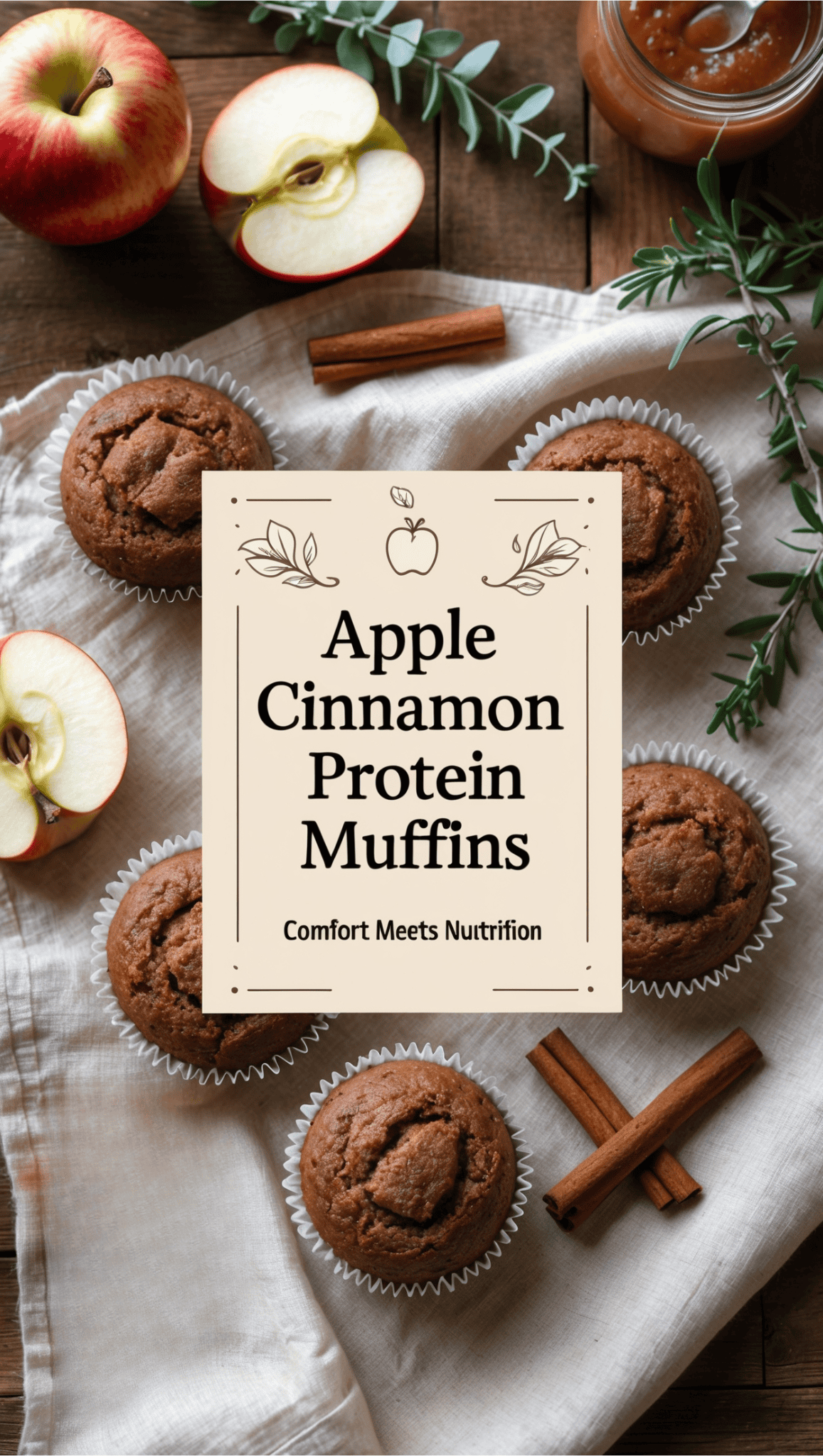
Apple cinnamon has always represented the ultimate comfort flavor combination in my kitchen, evoking memories of fall harvests and cozy afternoons! Transforming this classic pairing into a protein-rich breakfast option creates the perfect balance between nostalgic satisfaction and nutritional benefit. You’ll discover these muffins bring the essence of apple pie to your morning routine while providing the protein necessary to start your day with sustained energy.
What makes these muffins exceptional is the textural contrast between tender muffin base and chunks of real apple that maintain slight firmness after baking. The warming cinnamon complements both the apples and the vanilla protein powder, creating a cohesive flavor profile that feels indulgent despite its nutritional profile. I’ve found these to be particularly popular for meal prep as the flavors actually improve after a day in the refrigerator, allowing the apple and cinnamon notes to fully develop.
Apple Varieties for Baking
Honeycrisp, Granny Smith, and Braeburn apples maintain their structure during baking while providing different sweetness levels. Leaving the skin on red varieties adds visual appeal and additional fiber and antioxidants.
Cinnamon’s Health Properties
Beyond its delicious flavor, cinnamon helps regulate blood sugar and has anti-inflammatory properties. Using Ceylon cinnamon provides the best flavor and health benefits compared to more common Cassia varieties.
Texture Enhancement Techniques
Dicing apples into small, consistent pieces ensures even distribution and proper baking. Pre-cooking half the apples creates a flavor-packed apple sauce base while reserving fresh chunks for textural contrast.
How to Make Apple Cinnamon Protein Muffins
- Preheat oven to 350°F and prepare your muffin tin with liners
- Sauté 1 diced apple with 1 tsp cinnamon until soft, set aside to cool
- Combine 2 eggs, ¼ cup applesauce, 3 tbsp maple syrup, 2 tbsp melted coconut oil, and 1 tsp vanilla extract
- In a separate bowl, mix 1 cup oat flour, 2 scoops vanilla protein powder, 2 tsp cinnamon, 1 tsp baking powder, ½ tsp baking soda, and ¼ tsp salt
- Combine wet and dry ingredients, then fold in cooked apples and 1 additional diced raw apple
- Top with a sprinkle of cinnamon before baking
- Bake for 20-22 minutes until golden brown
- Cool completely before storing
Picture This
The comforting aroma of apples and cinnamon wafts through your kitchen, reminiscent of grandma’s apple pie but without the guilt. Biting into a warm apple cinnamon protein muffin reveals pockets of tender apple surrounded by moist, cinnamon-spiced muffin with a protein content that transforms this treat into a legitimate breakfast option. As you enjoy each bite, you appreciate how these high-protein apple cinnamon muffins bridge the gap between wholesome nutrition and comfort food—providing approximately 10g of protein per muffin while delivering authentic apple pie flavor. These muffins have become your secret weapon for satisfying sweet cravings in a way that supports rather than sabotages your health goals, proving that strategic baking can truly offer the best of both worlds.
7. Savory Egg and Vegetable Protein Muffins
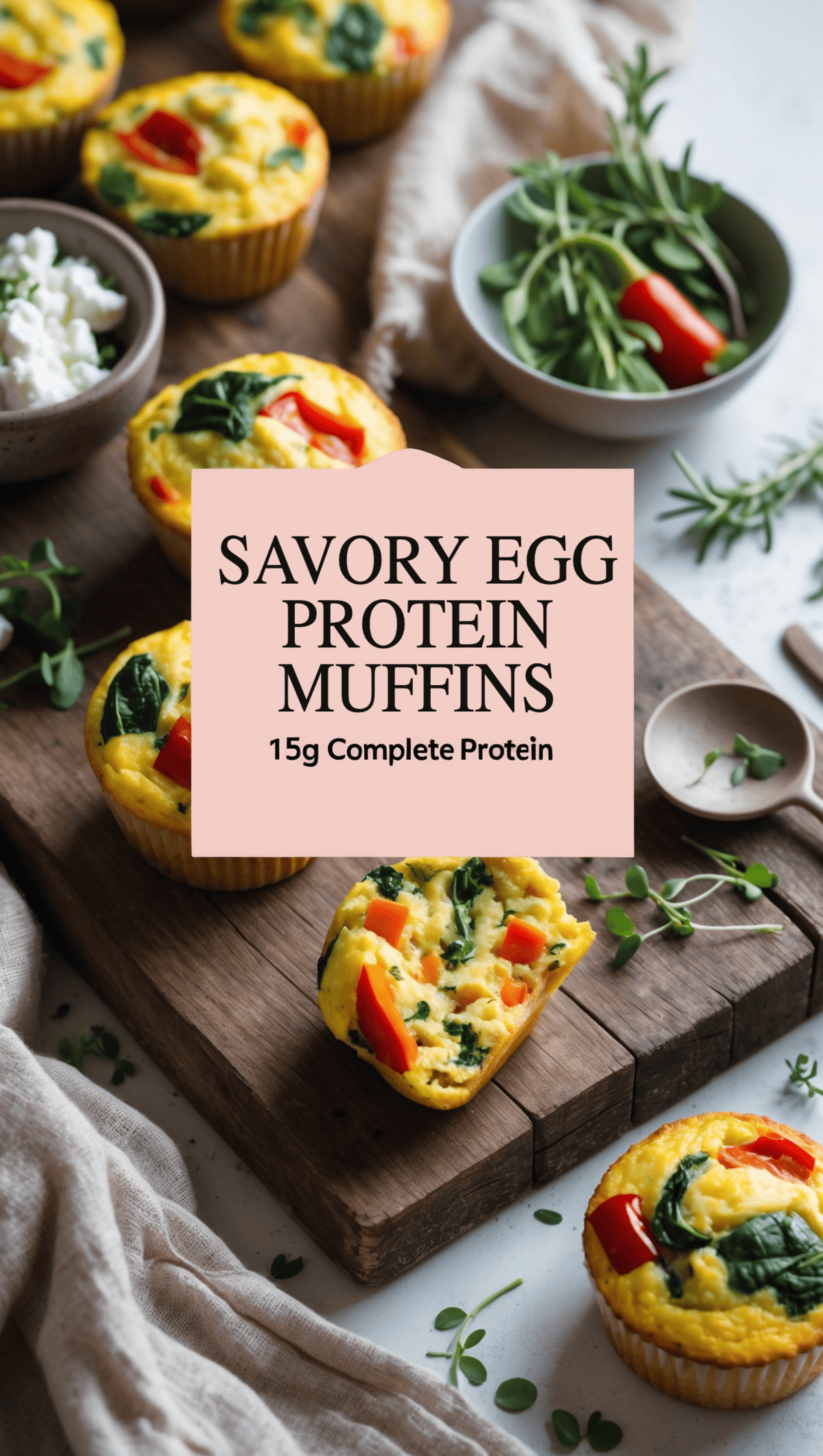
Breaking away from sweet breakfast options, I discovered these savory egg muffins during a period when I was growing tired of traditional protein-packed morning meals! The versatility of these savory cups makes them perfect for breakfast, lunch, or even a protein-rich snack between meals. You’ll appreciate how these egg-based muffins provide complete protein along with vegetables and optional lean meats in a convenient, portable format that can be enjoyed hot or cold.
What distinguishes these muffins is their impressive protein content—approximately 12-15g per muffin—coming primarily from whole eggs and egg whites, with additional protein from any cheese or meat additions. The absence of flour makes these naturally gluten-free and appropriate for those following low-carb or ketogenic approaches. I frequently prepare a large batch with varying vegetable combinations to ensure nutritious, protein-rich options are always available for busy days when cooking isn’t possible.
Complete Protein Benefits
Eggs provide one of nature’s most complete protein sources, containing all essential amino acids in an easily digestible format. Their natural fat content helps with vitamin absorption from the vegetables.
Vegetable Customization Options
Bell peppers, spinach, mushrooms, and zucchini work particularly well in these muffins, contributing micronutrients and fiber. Roasting vegetables before adding them intensifies flavor while removing excess moisture.
Meal Prep Convenience
These savory muffins maintain their texture and flavor for up to five days refrigerated. They can be enjoyed cold, at room temperature, or quickly reheated, making them ideal for meal preparation.
How to Make Savory Egg and Vegetable Protein Muffins
- Preheat oven to 375°F and generously grease a muffin tin
- Sauté 1 cup mixed chopped vegetables (bell peppers, spinach, onions) until soft
- In a large bowl, whisk together 6 whole eggs and 4 egg whites
- Add ¼ cup cottage cheese, sautéed vegetables, 2 tbsp chopped fresh herbs, salt, and pepper
- Optional: Add ¼ cup diced lean ham or turkey
- Pour mixture into muffin cups, filling about ¾ full
- Top with a sprinkle of grated parmesan cheese
- Bake for 20-25 minutes until puffed and set
- Allow to cool slightly before removing from tin
Picture This
Morning sunlight illuminates your kitchen as you package several savory egg muffins for your day ahead. Each one is a beautiful mosaic of colorful vegetables suspended in protein-rich egg—red bell peppers, green spinach, and caramelized onions visible beneath a light golden cheese crust. You know these high-protein egg muffins will power you through your busy schedule, providing complete nutrition in a convenient package that requires no utensils or reheating. Later that day, between meetings, you enjoy one straight from your insulated lunch bag, appreciating how its satisfying savory flavor and protein content keeps you focused without the heaviness of typical fast food options, demonstrating that protein-packed meals can be both practical and delicious.
8. Greek Yogurt Berry Protein Muffins
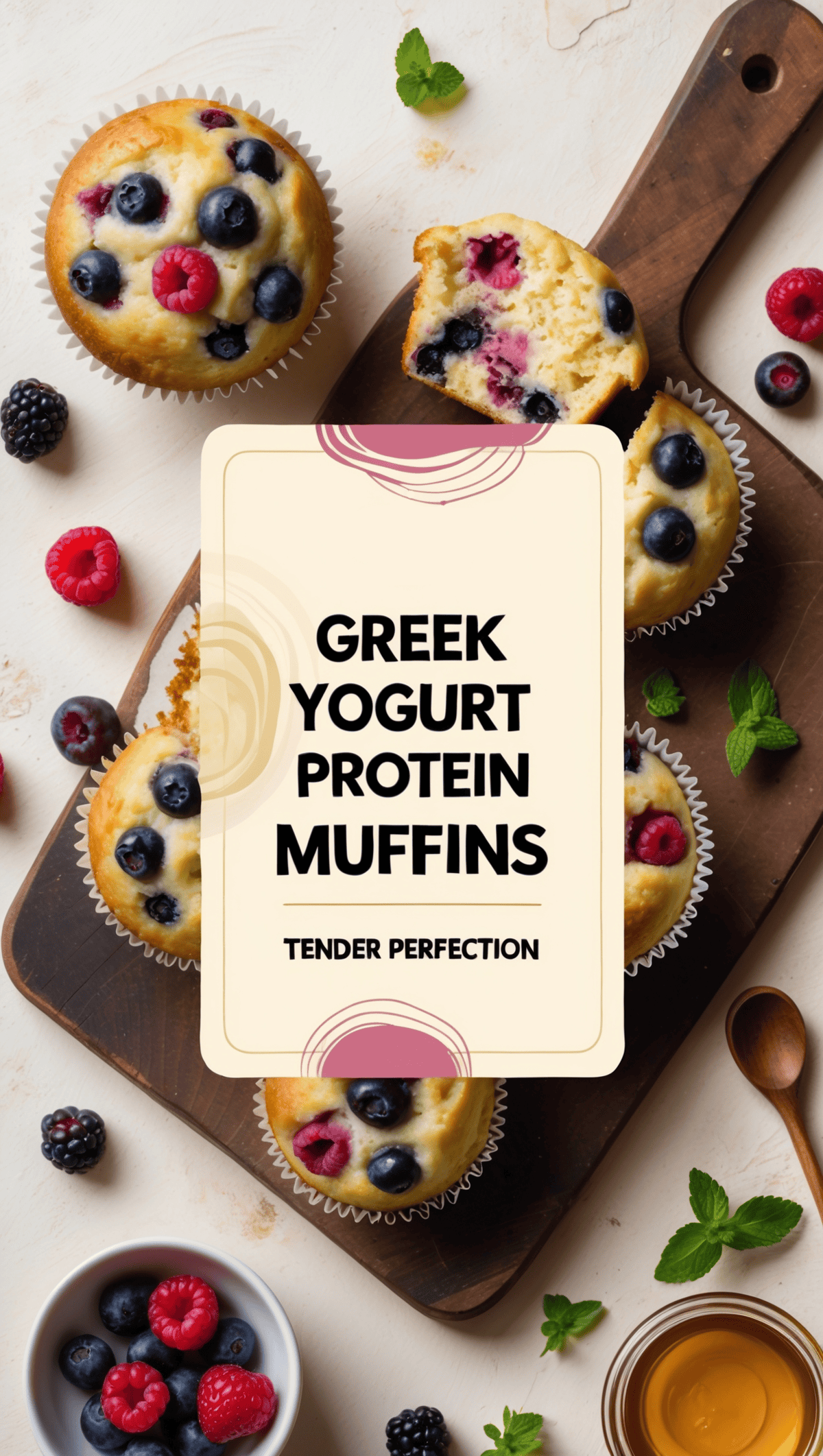
Greek yogurt revolutionized my protein baking when I discovered its remarkable ability to create moisture without excessive fat while boosting protein content! These berry-studded muffins showcase yogurt as both a protein source and texture enhancer, creating a tender crumb that remains moist for days. You’ll find the subtle tanginess of Greek yogurt complements the sweetness of mixed berries perfectly, creating a balanced flavor profile that works for breakfast or snacking.
What makes these muffins special is their impressive protein-to-carbohydrate ratio, with approximately 11g of protein per muffin coming from a combination of Greek yogurt and protein powder. The addition of mixed berries provides antioxidants, fiber, and natural sweetness without excessive sugar. I’ve found these particularly popular with those new to protein baking, as the familiar flavor profile and beautiful appearance make them approachable while their nutritional profile supports various health goals.
Greek Yogurt’s Dual Benefits
Beyond adding approximately 5g of protein per muffin, Greek yogurt creates exceptional moisture and tenderness. Its acidity also activates baking soda, creating better rise without needing additional leavening agents.
Berry Selection Strategy
Mixing blueberries, raspberries, and blackberries provides visual appeal and a complex flavor profile. Using frozen berries works perfectly year-round—keeping them frozen until folding into batter prevents color bleeding.
Achieving the Perfect Sweetness
The natural sweetness from berries reduces the need for added sweeteners. Adding a touch of honey or maple syrup enhances flavors without overwhelming the nutritional profile with excessive sugars.
How to Make Greek Yogurt Berry Protein Muffins
- Preheat oven to 350°F and prepare your muffin tin with liners
- Combine 1 cup Greek yogurt, 2 eggs, 3 tbsp honey, 2 tbsp melted coconut oil, and 1 tsp vanilla extract
- In a separate bowl, mix 1 cup oat flour, 2 scoops vanilla protein powder, 1 tsp baking powder, ½ tsp baking soda, and ¼ tsp salt
- Gently combine wet and dry ingredients without overmixing
- Carefully fold in 1 cup mixed berries (fresh or frozen)
- Bake for 20-22 minutes until lightly golden
- Cool completely before storing
Picture This
Steam rises from a freshly baked Greek yogurt berry protein muffin as you break it open, revealing a tender interior studded with juicy berries that have maintained their shape and vibrant color. The contrasting textures—moist, protein-rich muffin with bursts of berry juiciness—create a sensory experience that belies the muffin’s nutritional profile. These high-protein Greek yogurt berry muffins have become your weekend brunch staple, equally appreciated by health-conscious friends and those simply seeking something delicious. As you enjoy each bite, you appreciate how strategic ingredient choices transform a traditional treat into a protein-packed option that supports your active lifestyle while delivering genuine baking satisfaction without compromising on flavor or texture.
Common Mistakes to Avoid When Making Protein Muffins

My protein baking journey began with countless dense, rubbery failures before I understood the fundamental differences between traditional and protein-enhanced baking! Learning from these mistakes saved me time, ingredients, and frustration as I refined my approach to creating truly delicious protein muffins. You’ll benefit from understanding these common pitfalls before attempting your own recipes, allowing you to achieve better results from your very first batch.
The science behind protein baking differs significantly from conventional methods—protein powder absorbs moisture differently than flour and requires specific techniques to prevent undesirable textures. Temperature control, ingredient ratios, and mixing methods all impact the final result dramatically. I’ve compiled these lessons from years of experimentation and countless batches of muffins that taught me what works—and what definitely doesn’t—when incorporating protein powder into baked goods.
The Overmixing Trap
Protein batters develop gluten and toughen quickly when overmixed, resulting in dense, rubbery muffins. Fold ingredients just until combined, accepting some visible streaks of flour rather than pursuing a perfectly smooth batter.
Protein Powder Proportions
Using too much protein powder creates dry, chalky muffins with unpleasant aftertaste. As a general rule, limit protein powder to 25-30% of your total dry ingredients for optimal texture and flavor balance.
Moisture Balance Challenges
Protein powder absorbs significantly more liquid than traditional flour. Incorporating moisture-rich ingredients like yogurt, applesauce, or mashed banana helps counteract this tendency toward dryness.
How to Perfect Your Protein Muffin Technique
- Allow refrigerated ingredients to reach room temperature before mixing
- Measure protein powder by spooning into measuring cups rather than scooping directly
- Check muffins 5 minutes before the recipe suggests as protein muffins can overbake quickly
- Let muffins cool in the tin for 5-10 minutes before transferring to a cooling rack
- Allow muffins to cool completely before storing to prevent condensation and sogginess
- Test a new protein powder in a small batch before committing to a full recipe
Picture This
You’re pulling a tray of perfectly domed protein muffins from the oven—a far cry from your early attempts that resembled hockey pucks more than breakfast treats! Through purposeful trial and error, you’ve mastered the nuances of protein baking, understanding exactly how to combine ingredients for optimal texture and flavor. These high-protein muffins rise beautifully, maintain moisture without becoming dense, and deliver balanced flavor that doesn’t betray their enhanced nutritional profile. Friends and family regularly request your protein muffins
Final Thoughts
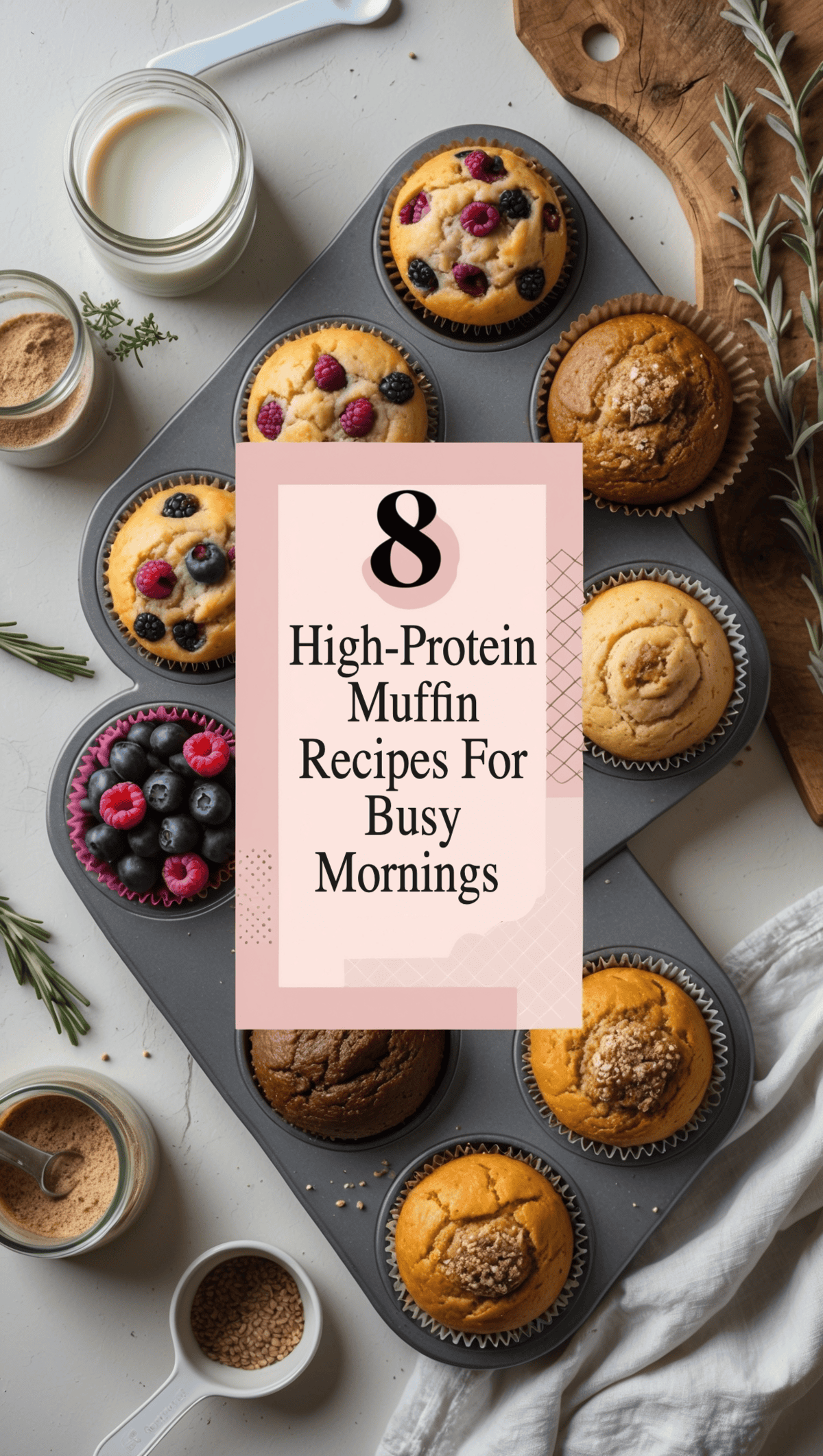
Incorporating high-protein muffins into your weekly meal prep routine can revolutionize how you approach nutrition without sacrificing flavor or adding stress to your busy schedule. These eight versatile recipes prove that healthy eating doesn’t require complicated ingredients or professional baking skills—just a willingness to experiment and the right techniques. Whether you prefer the classic comfort of blueberry, the indulgence of chocolate banana, or the savory satisfaction of egg and vegetable muffins, there’s a protein-rich option to match your taste preferences while supporting your health goals.
The beauty of these recipes lies in their adaptability. As you become more comfortable with protein baking principles, you’ll naturally begin creating your own variations based on seasonal ingredients and personal preferences. Remember that successful protein baking is about balance—finding the right ratio of protein powder to moisture-adding ingredients ensures muffins that are nutritious without sacrificing that tender, bakery-quality texture we all crave.
Take the plunge this weekend by selecting one recipe that appeals to your taste buds and fits your nutritional needs. Within an hour, you’ll have a week’s worth of grab-and-go breakfasts that keep you energized, satisfied, and on track with your health journey. Your future self will thank you each hectic morning when a delicious, protein-packed breakfast is ready and waiting!
This post may contain some affiliate links. I only recommend products and services I genuinely believe in. Additionally, some content on this website may have been created with the help of AI.
Frequently Asked Questions
Can I substitute different protein powders in these recipes?
Absolutely! While whey protein tends to produce the most tender texture in baked goods, plant-based alternatives like pea, hemp, or brown rice protein can be substituted with some adjustments. You may need to increase moisture-adding ingredients slightly when using plant proteins as they tend to absorb more liquid than whey. Always start with a high-quality, minimally processed protein powder with a flavor profile that complements your recipe, and be prepared to adjust your recipe slightly through experimentation.
How long do protein muffins stay fresh?
Protein muffins typically maintain their best quality for 2-3 days when stored in an airtight container at room temperature, or up to 5 days when refrigerated. For longer storage, these muffins freeze exceptionally well for up to three months when wrapped individually in plastic wrap and placed in a freezer-safe container or bag. To enjoy a frozen muffin, either thaw overnight in the refrigerator or microwave for 20-30 seconds for a quick breakfast that tastes nearly as fresh as the day you baked it.
Why do my protein muffins collapse after baking?
Collapsed protein muffins usually result from either removing them from the oven too early or overmixing the batter which develops too much gluten. Ensure muffins are fully baked by inserting a toothpick into the center—it should come out clean or with a few moist crumbs, but no wet batter. Allow muffins to cool in the tin for 5-10 minutes before transferring to a cooling rack, as this transition period helps them set properly without dramatic temperature changes that can cause collapse.
Can these protein muffins help with weight management?
High-protein muffins can be valuable tools for weight management when incorporated thoughtfully into your nutrition plan. The protein content helps increase satiety, preventing the hunger spikes that often lead to unplanned snacking or larger meals later in the day. Additionally, the balanced macronutrient profile in these recipes provides sustained energy without the blood sugar fluctuations associated with traditional baked goods. For best results, pair a protein muffin with additional protein sources like Greek yogurt or eggs to create a complete meal that supports your specific caloric and nutritional needs.
How can I increase the protein content even further?
To boost the protein content of any muffin recipe, consider adding protein-rich ingredients like collagen peptides (which blend seamlessly without affecting taste), egg whites in place of whole eggs, or replacing part of the liquid with liquid egg whites. Another effective strategy is incorporating cottage cheese into the batter, which adds approximately 13g of protein per half cup while contributing to moisture and tenderness. For nut-containing recipes, chopping nuts more finely increases the amount you can incorporate, adding both protein and healthy fats without drastically changing the muffin’s texture or flavor profile.
About The Author
Jahlila is a Transformational Whole Self and Wellness Lifestyle Empowerment Coach, a devoted mother, passionate writer, and a fervent advocate for holistic wellness. She is the creator of The Tri-Sync Method, a comprehensive coaching program designed to help women establish a personalized wellness and self-care lifestyle for enduring total health wellness.
Her journey has transitioned from focusing solely on health and fitness to embracing a broader mission: empowering women through holistic approaches that unite body, mind, and spirit. Jahlila is dedicated to teaching, coaching, writing, and speaking about how wellness intersects with a joyful, balanced life. Her mission is to motivate women to prioritize and achieve their wellness goals, fostering a deep connection between a vibrant lifestyle and true happiness. Ready to reclaim your vitality, achieve mental clarity, and embrace your wellness journey? Explore more at The Tri-Sync Method.Com
Don’t wait another day to start living your healthiest, happiest life. Schedule a Free Discovery Consultation with Jahlila today to explore how The Tri-Sync Method can transform your life. For additional questions or personalized guidance, please visit our Contact Page.

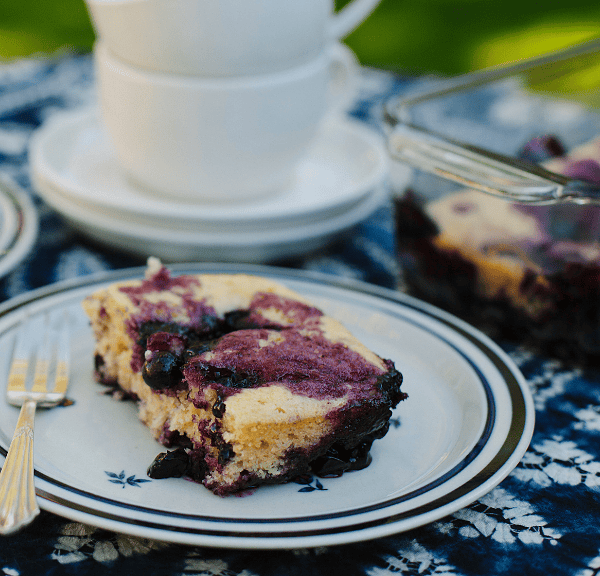
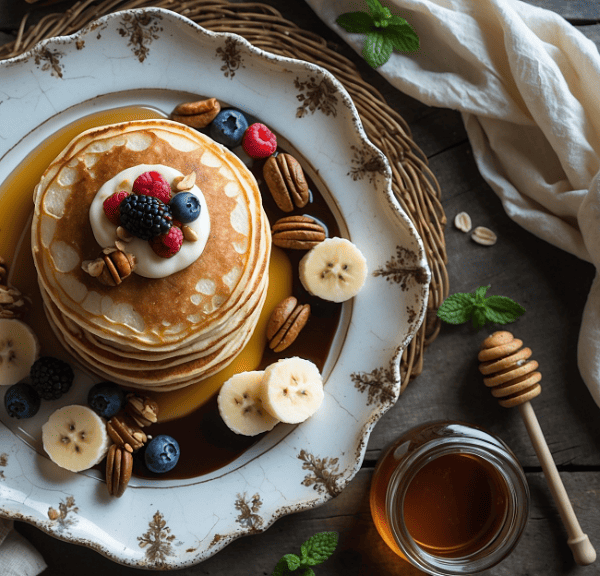

Leave a Reply